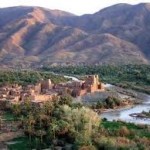The Wallace Street Journal
November 21, 2012.
Ouarzazate, Morocco – Its beaches fronting the Atlantic and the Mediterranean on thenorthwestern coast of Africa, the constitutional Kingdom of Morocco is a cacophony of colour.
Ouarzazate (pron. Wa-za-ZAT), a city of a million and half or so, is Africa’s Hollywood, the taking-off point for film-makers who want to tell a pictorial story of desert life, in movies such asLawrence of Arabia, The Man Who Would Be King, Asterix and Obelix, Kingdom of Heaven, and Babel, to name a few.
If you’ve ever seen a movie about World War II with desert in the background, it was probably shot out of Atlas Studios here near the casbah. Stone buildings the colour of the nearby mountain rocks rise majestically from this place. Vineyards and orchards and villages that predate the New Testament cling to verdant hillsides.
Morocco is a Muslim country, and it is a kingdom – albeit a constitutional monarchy. But you hear the words Muslim and Africa and kingdom in the same sentence, no doubt you’re tempted to run like the wind. You shouldn’t. It’s a mellow, spectacular place where the men drink locally-made wine and women drive cars, vote, earn educations and hold high offices. It is governed by King Mohammed VI, who is still in his forties. Renault and Nissan build cars here.
Morocco escaped the so-called Arab Spring and its violence precisely because King Mohammed VI understands his country’s demographics. Young unemployed males, when they’ve nothing to do, no money to earn, no pride to claim, are naturally going to go crazy. They are despondent and who can blame them? So they blow up an airliner in exchange from somehonyock imam’s promise of a better afterlife.
So the king and his elected parliament have put the kids to work. The youth are building freeways and real city infrastructures. You can sail from Casablanca on the coast to Marrakesh in the Atlas Mountains in three hours over smooth, concrete-paved freeways, and in another three hours you’re in Ouarzazate. Morocco is gently corrupt. Blast through a speed-trap, the fuzz pull you over, you negotiate the fine, pay in cash, and you’re outta there. No court appearance. No mark on your permanent record.
One thing Morocco is doing is opening up its prodigious silver, gold, lead, zinc and copper mineral deposits to foreign exploration and development.
Mining has been a staple of the Moroccan economy since Biblical times: mining’s current contribution to the country’s GDP is north of 10 per cent, primarily from its state-owned, export-intensive potash/phosphate mining. The country will fill, according to a North Carolina State University study, between 80 per cent and 90 percent of global phosphate demand through the next two decades.
Fouad Douiri, Minister of Energy, Mining, Water and Environment for the Kingdom of Morocco, told me his country is open for business when it comes to metal mining. “Morocco has a promising mineral potential, significant expertise, and a skilled and inexpensive labour force. We have undertaken a series of actions and reforms aimed at further promoting this vital sector through the encouragement of the private sector,” Douiri said.
(Morocco ranked 17th in world silver production in 2011, according to the Silver Institute. The primary source of its silver output is the 5.48-mil/oz/year Imiter mine, ranked as the world’s 14th-largest silver producer. But there are many more coming on line, including Canadian junior Maya Gold & Silver’s Zgounder silver mine, discovered in the third century AD.)
Maya’s CEO, Guy Goulet, a delightful French-Canadian chap, observed on our trip through the Atlas Mountains: “Today, there are one or two Canadian exploration companies down here. Next year there will be two dozen.” I improperly overheard from others that mining billionaireTom Kaplan, new owner of the Sunshine silver mine, is one of the tire-kickers.
Morocco has a unique and enduring relationship with the United States. It was the first nation to recognize U.S. sovereignty, in 1777, and the Moroccan-American Friendship Treaty is the United States’ oldest, signed in 1786 by Thomas Jefferson, John Adams and Sultan Muhammad III. The treaty granted Moroccan cover to the fledgling U.S. merchant marine service under attack from Libyan pirates launched from the infamous Barbary Coast.
The U.S. and Morocco entered into a free trade agreement on June 15, 2004. Shares in Morocco’s mining companies have traded on the Casablanca Stock Exchange since 1929.
Morocco ducked the violence of Arab Spring, and hasn’t sent any shoe- or underwear-bombers our way. It’s because when the young men of Morocco are blowing up silver-bearing rocks for a decent living, they don’t feel the need to blow up buildings, airliners and themselves.
Mining to the rescue, once again. People didn’t crawl through 1,000 miles of broken glass to get a tan on Coeur d’Alene Lake 120 years ago. They came here to work and to find wealth. That should be a lesson for the current nose-picking architects of our own economic woes and the authors of the desperation of our youth.








